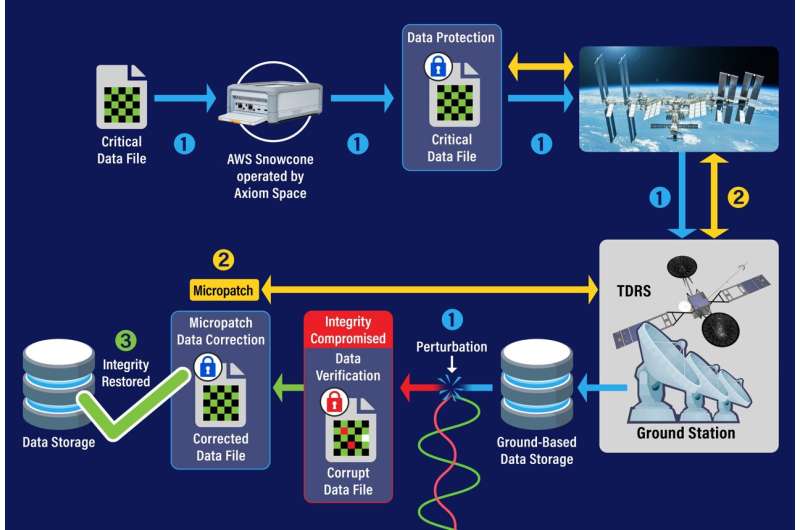This article has been reviewed according to Science X's editorial process and policies. Editors have highlighted the following attributes while ensuring the content's credibility:
fact-checked
trusted source
proofread
Micropatch algorithm improves ground-to-spacecraft software update efficiency

Southwest Research Institute developed an algorithm to remotely update and repair spacecraft software using less time and data than conventional techniques.
The tool not only improves the overall efficiency of satellite software transmissions but also can recover data from failed over-the-air updates and malicious cyberattacks. It works by identifying missing bytes and other errors before deploying a custom "micropatch" to the damaged or missing software.
"Instead of updating an entire file or operating system, which is typically required with over-the-air satellite software updates, our tool can find and patch smaller errors," said Henry Haswell, a research engineer in SwRI's Intelligent Systems Division. Haswell will present a research paper titled "Secure Micropatching on the ISS" at DEF CON 31, August 10-13, in Las Vegas.
The researchers successfully deployed and tested the tool on the International Space Station (ISS) on June 25. SwRI worked with Axiom Space Inc. and Amazon Web Services (AWS) to upload and evaluate the micropatch technology on an Axiom Space-operated computer on the ISS. Axiom Space collaborated with AWS to bring this AWS Snowcone computer to the ISS as part of the Ax-1 mission.
"This real-world demonstration proved the advantages of using this powerful technology," said Diego Alducin, an SwRI computer scientist. "You can test for months in a lab on Earth, simulating all kinds of scenarios, but the true test happens in the harsh conditions of space.
Updating satellite software through sluggish telemetry networks with limited bandwidth and intermittent contacts can interrupt updates and corrupt files in the process. When that occurs, the current standard is to resend the entire file over the network. However, that typically requires waiting for a window when a satellite is aligned with a ground station. This window can be as short as eight minutes and might only occur once every few days.
"We focused our research on reducing the size of data retransmissions because that is critical in reducing mission downtime," Alducin said.
While other technologies address network interruptions, they can be cost-prohibitive. Some spacecraft use error detection and correction, or EDAC software, to correct transmission errors, but these applications are power-hungry and have a large memory footprint.
Prior to ISS testing, SwRI lab-tested five algorithms, simulating several corruption modes. The lab research identified a double breakpoint search (DBS) algorithm as the most promising solution for Earth-to-space deployment. A DBS patch addresses a variety of complex file errors such as insertion, modification and deletion, while legacy systems can only fix simple issues.
SwRI is planning the next phase of research to reduce the number of messages needed to update a file while maintaining the same error correction capabilities. Researchers also hope to enhance micropatching continuity, enabling seamless file transfers in the event of temporary connection loss.
The space micropatching research builds on an automotive cybersecurity tool that SwRI developed for securing over-the-air, or OTA, updates on cars and trucks. SwRI's High Reliability Systems Department develops mission-critical systems for the aerospace, automotive, oil and gas, critical infrastructure and transportation industries. SwRI's Intelligent Systems Division is a leader in development of software, cybersecurity, artificial intelligence, data analytics and systems engineering solutions.
Provided by Southwest Research Institute





















